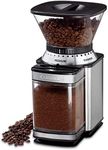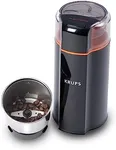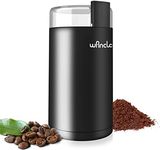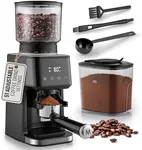Buying Guide for the Best Electric Coffee Grinders
Choosing the right electric coffee grinder can significantly enhance your coffee brewing experience. The right grinder will ensure that your coffee beans are ground to the perfect consistency, which is crucial for the flavor and aroma of your coffee. When selecting an electric coffee grinder, consider the following key specifications to find the best fit for your needs.Grind SettingsGrind settings refer to the different levels of coarseness or fineness that the grinder can produce. This is important because different brewing methods require different grind sizes. For example, espresso requires a very fine grind, while French press needs a coarse grind. Grinders with multiple settings offer more versatility. If you enjoy experimenting with different brewing methods, look for a grinder with a wide range of settings. If you stick to one method, a grinder with fewer settings may suffice.
Burr TypeBurr type refers to the mechanism that grinds the coffee beans. There are two main types: flat burrs and conical burrs. Flat burrs are known for producing a consistent grind size, which is ideal for espresso. Conical burrs are quieter and produce less heat, which can preserve the flavor of the coffee. If you are an espresso enthusiast, a flat burr grinder might be the best choice. For general use and versatility, a conical burr grinder is a great option.
Grind Size ConsistencyGrind size consistency is crucial for achieving a balanced and flavorful cup of coffee. Inconsistent grind sizes can lead to uneven extraction, resulting in a bitter or weak taste. High-quality grinders produce uniform grind sizes. If you are particular about the taste of your coffee, invest in a grinder known for its consistency. For casual coffee drinkers, a slight variation in grind size may not be as noticeable.
CapacityCapacity refers to the amount of coffee beans the grinder can hold and grind at one time. This is important if you regularly brew large quantities of coffee. Grinders with larger capacities are convenient for households with multiple coffee drinkers or for those who entertain guests often. If you typically brew just a cup or two at a time, a grinder with a smaller capacity will be sufficient and may take up less counter space.
SpeedSpeed refers to how quickly the grinder can process the coffee beans. High-speed grinders can be more efficient but may generate more heat, which can affect the flavor of the coffee. Low-speed grinders, also known as 'direct drive' grinders, tend to be quieter and produce less heat. If you prioritize speed and convenience, a high-speed grinder might be suitable. If you are more concerned about preserving the flavor and aroma of your coffee, opt for a low-speed grinder.
Ease of CleaningEase of cleaning is an important factor to consider, as coffee grinders can accumulate oils and residues that affect the taste of your coffee. Some grinders have removable parts that make cleaning easier. If you prefer low-maintenance appliances, look for a grinder that is easy to disassemble and clean. Regular cleaning is essential to maintain the grinder's performance and the quality of your coffee.
Noise LevelNoise level refers to how loud the grinder is during operation. This can be an important consideration if you are sensitive to noise or if you grind coffee early in the morning when others are sleeping. Grinders with quieter motors or sound-dampening features are ideal for minimizing noise. If noise is not a major concern for you, this specification may be less critical.





















